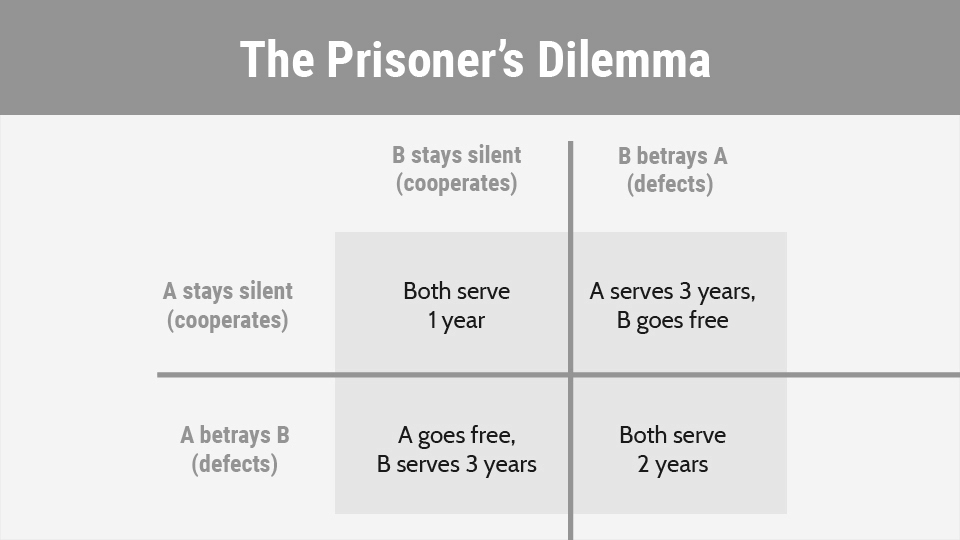Introduction
In the realm of decision-making, the mental model known as the “Prisoner’s Dilemma” holds significant relevance. The Prisoner’s Dilemma represents a scenario where individuals or groups face a choice between cooperation and betrayal, and the outcomes depend on the decisions made by all parties involved. This blog post aims to provide a comprehensive exploration of the Prisoner’s Dilemma mental model, its prevalence in decision-making, examples of its occurrence in various contexts, biases that contribute to it, strategies to identify and overcome it, and the implications of awareness.
Defining the Prisoner’s Dilemma and Its Relevance in Decision-Making
The Prisoner’s Dilemma is a mental model rooted in human psychology and social interactions. It illustrates a situation where individuals must decide whether to cooperate with each other for mutual benefit or act in their own self-interest. The essence of the dilemma lies in the tension between short-term individual gains and long-term collective gains.
The relevance of the Prisoner’s Dilemma in decision-making stems from its prevalence in our day-to-day lives. It mirrors situations where people face choices that require balancing personal interests with the potential risks and benefits of cooperation. Understanding this mental model can help individuals navigate complex decision-making scenarios and make choices that maximize collective welfare.
Examples of the Prisoner’s Dilemma in Various Contexts
Personal Life Decisions:
Consider a situation where two friends need to decide whether to share the cost of an expensive gift for a mutual friend’s birthday. If both friends choose to cooperate and contribute equally, they can afford a more significant and meaningful gift. However, if one friend decides to betray the other by not contributing while expecting the other to bear the entire cost, the cooperative outcome is compromised. In this scenario, both friends face the dilemma of whether to trust and cooperate or act in their own self-interest, potentially damaging their friendship.
Business Scenarios:
In the business world, the Prisoner’s Dilemma often arises in competitive situations. For instance, in an industry where multiple companies have the option to either collude and set higher prices collectively or undercut each other to gain market share, the dilemma lies in balancing short-term gains with the long-term health of the industry. Individually, each company may benefit from betraying the collective agreement and undercutting prices. However, if all companies pursue this self-interest, it leads to price wars, reduced profits, and a weaker market overall.
Public Policy-Making:
The Prisoner’s Dilemma also manifests in public policy-making. Consider the allocation of limited resources in a community. Each stakeholder, such as government agencies or interest groups, must decide whether to cooperate and distribute resources equitably or act in their own self-interest by lobbying for a larger share. If all stakeholders choose to prioritize their own interests, it can lead to a suboptimal allocation of resources, exacerbating social inequalities and harming the community as a whole.
Mental Biases and Psychological Underpinnings of the Prisoner’s Dilemma
Several cognitive biases contribute to the occurrence of the Prisoner’s Dilemma in decision-making. One prominent bias is the fear of exploitation, where individuals anticipate being taken advantage of if they choose to cooperate. This fear can lead to a defensive approach, with individuals prioritizing self-interest over collective gains, even when cooperation may be mutually beneficial.
Another psychological underpinning is the zero-sum thinking, where individuals perceive situations as win-lose scenarios, assuming that one party’s gain must come at the expense of others. This mindset can hinder cooperation as individuals become focused on maximizing their own gains and view cooperation as a risk or potential loss.
Identifying and Overcoming the Prisoner’s Dilemma Biases
To navigate the biases associated with the Prisoner’s Dilemma, individuals can employ the following strategies:
Promote Trust and Communication: Building trust and fostering open communication among decision-makers can help mitigate the fear of exploitation. Establishing clear expectations, emphasizing shared goals, and encouraging dialogue create an environment where cooperation is more likely to occur.
Incentivize Cooperation: Designing systems or structures that reward cooperation can help overcome zero-sum thinking. By highlighting the benefits of mutual cooperation and creating incentives for collaborative behavior, individuals are more likely to prioritize collective gains over short-term self-interest.
Long-Term Thinking: Encouraging a long-term perspective can counteract the allure of immediate gains. By considering the potential benefits that can arise from sustained cooperation and recognizing the risks of betraying trust, individuals can make more rational decisions that prioritize long-term collective welfare.
Conclusion
The Prisoner’s Dilemma serves as a valuable mental model for understanding decision-making scenarios where cooperation and self-interest intersect. By recognizing its prevalence in personal, business, and public policy contexts, individuals can navigate complex dilemmas more effectively. Understanding the biases and psychological underpinnings associated with the Prisoner’s Dilemma allows for informed decision-making and the pursuit of outcomes that balance individual interests with collective welfare. By promoting trust, incentivizing cooperation, and adopting a long-term perspective, individuals can overcome the challenges posed by the Prisoner’s Dilemma and contribute to more favorable and collaborative outcomes.
